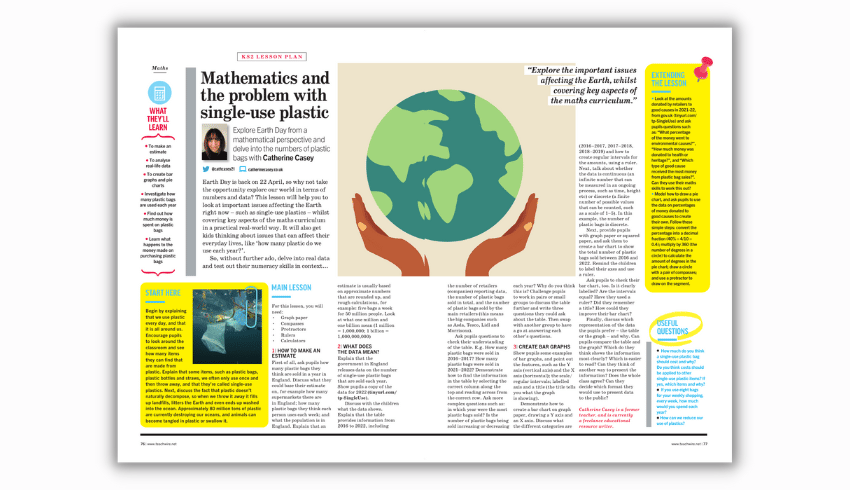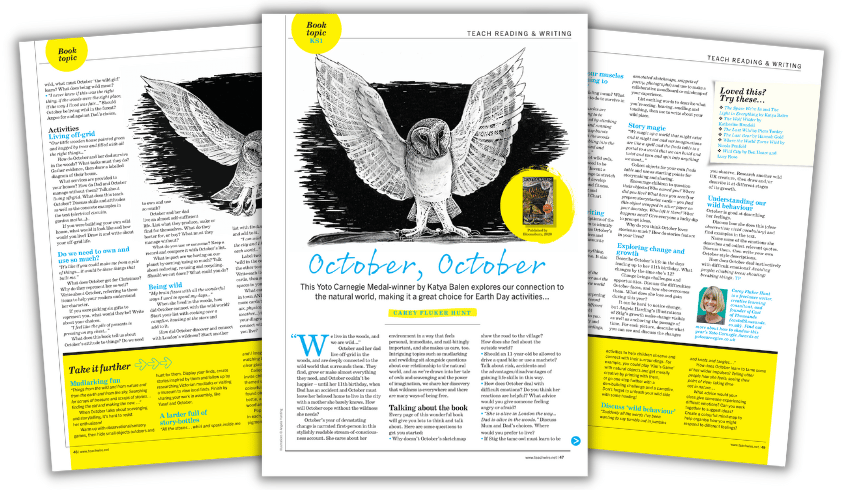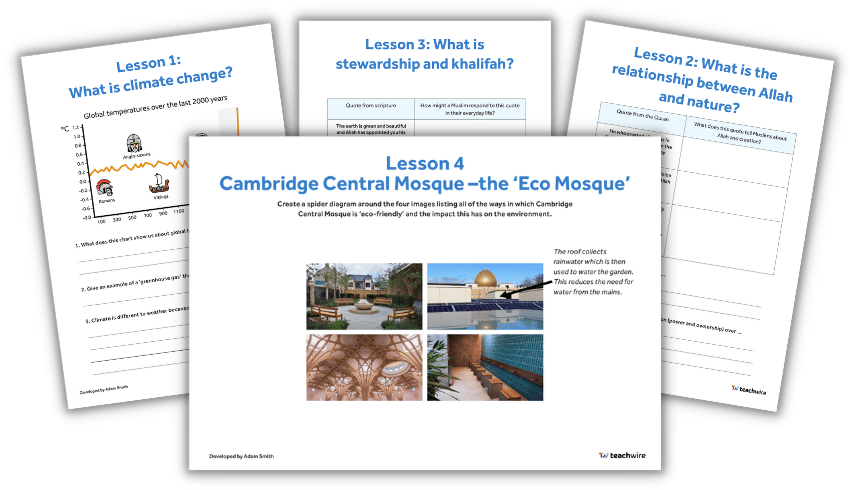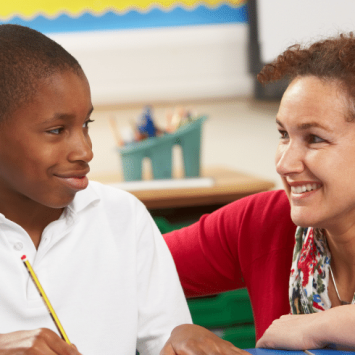Earth Day 2023 – Great activity ideas for schools

Celebrate Earth Day in your school with these free resources, activities and ideas…

- by Teachwire

What is Earth Day?
Earth Day happens every year on April 22nd to raise awareness for environmental concerns.
The first Earth Day was held in 1970. It’s now a popular hook for schools to use to have conversations with pupils around climate change.
Celebrations include various events coordinated globally by earthday.org. Around 1 billion people in more than 193 countries take part.
The official theme for 2023 is Invest in Our Planet.
When is Earth Day?
This year, Earth Day is celebrated on 22nd April 2023.
KS2 maths lesson

This free KS2 maths lesson plan will help you to look at the important issue of single-use plastics with your class. You’ll cover key aspects of the maths curriculum in a practical, real-world way by delving into real data.
Climate change debate reading and writing activity

This free resource pack for KS2 includes a story about the heatwave of 2020 from The Week Jr newspaper, plus a sheet of activities designed to get children talking, thinking and writing about the world around them.
KS2 book topic

October, October by Katya Balen explores our connection to the natural world, making it a great choice for Earth Day. Every page of this wonderful book will give your class lots to think about. Use this free plan to explore the book in a cross-curricular way.
KS2 RE medium term plan

Lots of subjects lend themselves to climate discussions, including RE. This free medium term plan by Adam Smith explores stewardship in Islam, how the Hajj pilgrimage is being affected by the climate and more.
How to teach about the climate

Want to engage your pupils with the crisis without scaring them? Try these ideas from Nicola Penfold to show children the happy side of environmentalism…
1. Find relevant books
There are many brilliant, engaging, thought-provoking stories out there to capture your students’ imagination and interest, including The Last Bear by Hannah Gold, Where the River Runs Gold by Sita Brahmachari and The Last Wild books by Piers Torday.
For younger children, there’s a raft of picture books about protecting nature and plastic in the ocean, etc.
These titles generate conversation and empower change. They can also be prompts for creative writing.
A ‘climate-fiction’ story provides an intriguing setting and a ready-made goal (finding clean water / air / land / food / justice). Pupils can write survival stories, journeys and revolutions.
2. Get gardening
The nature crisis comes hand-in-hand with the climate crisis. Teach them together. Schools can make a big difference to biodiversity locally.
If every school encourages wildlife into its grounds – wildflowers, log piles, bird feeders, ivy screens separating playgrounds from roads – this adds to nature corridors up and down our country and allows more species to thrive.
It enables all pupils to play a part in protecting their local environment, too, whether they have outside space at home or not.
3. Go outside
Being in nature is good for us. The evidence is overwhelming. It makes us happier, healthier, calmer, even kinder.
Make time to take your class outside to any wilder areas in your school grounds, or visit local green spaces.
Enjoying being in the natural world is a gift you can give your pupils that, like reading for pleasure, they can benefit from their entire lives.
“Enjoying being in the natural world is a gift you can give your pupils”
The climate and biodiversity crisis are the biggest challenges we face, and there are difficult times ahead, especially for younger generations.
Many young people know this and are frightened. Equip them with the solace nature can provide.
4. Model eco-friendly behaviour
Reducing waste, encouraging recycling, introducing meat free days, avoiding single use plastic, starting a school compost heap – these habits spread out to families and the benefit goes well beyond the classroom.
Don’t underestimate the power of what you model and teach. One of my daughters learned about palm oil and orangutans at school and this directly changed our family’s shopping habits.
5. Stay tuned to current events
Many organisations reach out to schools with climate education tools, for example WWF has free live lessons you can register for online.
All these things increase around Earth Day in April. Celebrate it in your school.
You can also have a go at identifying wildlife you see outside.
It doesn’t matter if your starting point is ignorance; show curiosity and learn alongside your pupils (or from the more nature-literate ones among them).
6. Find out about natural climate solutions
What is rewilding? What natural habitats capture and store carbon? It goes way beyond trees. When researching my book I was fascinated to learn about the part whales play in the climate.
They feed in the depths of the ocean, but return to the surface to poo. Their excrement feeds vast plumes of phytoplankton, which in turn captures carbon dioxide (four times as much as the Amazon rainforest!).
When a whale dies naturally, it sinks to the ocean floor and the carbon in its enormous body is locked away for centuries.
Knowing that the natural world has in-built climate solutions can give us hope, and also make us double down on our efforts to protect it.
Nicola Penfold is author of Beyond the Frozen Horizon (£7.99, Little Tiger).
Using trees to teach climate change in KS3

We hear from Forestry England how a discussion of trees can be the springboard for some powerful lessons on climate change…
Trees play a vital role in tackling the climate emergency, by absorbing carbon dioxide and storing it as carbon in the form of wood. They can also play an important role in reducing flooding and keeping our air clean.
Introduce your students to the role that well-managed forests play in tackling the climate emergency by watching the below video.
Whether your school is located near a forest or not, trees can still be used to spark useful discussion. The cross-curricular activities below can be completed sequentially over a number of weeks.
Remember that it’s important to reassure your students that actions they take now can have an important positive impact in future.
1. Get outside
Take students outside and ask them to hug a tree in the school grounds or your local area – it’s a fun way to introduce the topic.
Discuss the tree’s natural and seasonal processes. How does it function? Where does it store carbon? What role does it play in absorbing carbon dioxide and releasing oxygen?
2. Talk it through
Lead a discussion on how planting more trees can help ease local issues. Topics that could be covered here include sustainable timber, wildlife habitats and the wellbeing benefits of spending time in green spaces.
3. Self-reflect
Ask students to calculate how much carbon a specific tree can store, using this carbon capture activity sheet. Then ask students to research how much carbon they use themselves each day or week – this carbon footprint analysis table can provide a good starting point.
How many trees would you need to plant to offset this carbon, both individually and for the whole class?
4. Carry out an audit
Discuss whether there’s enough land to keep planting more trees to sequester our carbon needs. What else does your class think we could do collectively to help reduce carbon dioxide emissions?
Split students into smaller groups and ask them to walk around the school, carrying out an audit of small changes that can be made to help reduce carbon emissions.
Focus on areas such as energy, water, food, sustainable materials, waste, transport and biodiversity.
5. Weigh up the solutions
Review the groups’ audits during an open discussion, encouraging students to consider which suggestions are most cost effective versus those that will have the biggest impact.
Don’t forget to consider negative outcomes and mitigation tactics.
6. Draft a pledge
Use the information your students have gathered to draft a class pledge to tackle your school’s carbon footprint. Make sure it’s achievable and measurable, so that your class can see what difference they’re able to make.
Reassure your students that as individuals, we can have valuable impact – but that collectively, we can achieve so much more.
Forestry England’s climate change resource hub contains a range of free, curriculum-linked KS3 resources, including videos, case studies and student investigations.










